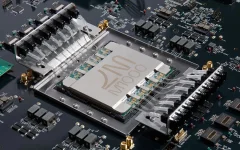Lightmatter just released their Passage M1000, a new type of 3D Photonic Superchip made for future XPUs and switches. This chip pushes optical bandwidth to 114 Tbps, breaking records for AI systems. The M1000 platform measures over 4,000 square millimeters. It works as a multi-reticle active photonic interposer that helps build the biggest die groups in 3D packages. It can link thousands of GPUs together as one system.
Current chip designs face limits because electrical connections must sit at chip edges. The M1000 fixes this problem by putting electro-optical connections almost anywhere on its surface for chips stacked above it. The interposer uses a big network of waveguides that can change how they carry high-bandwidth WDM optical signals through the M1000. With 256 fiber attachments built right in, the M1000 delivers ten times more bandwidth than normal Co-Packaged Optics in less space.
Lightmatter partnered with GlobalFoundries and Amkor to ensure that customers can produce designs based on the M1000 platform with top-quality standards. They use the GF Fotonix silicon photonics platform, which puts photonic parts together with fast CMOS logic on one die. Nick Harris, who started Lightmatter, says they beat industry timelines by years with this technology. He credits their success to working closely with foundry partners.
Dr. Thomas Caulfield from GlobalFoundries talked about their partnership with Lightmatter for AI data centers. The M1000 design uses their GF Fotonix platform and sets new standards for photonics. Vlad Kozlov from LightCounting pointed out how demand for more bandwidth drives new connection technologies, with the M1000 going beyond existing solutions. The M1000 comes with impressive tech specs - it has eight tiles, 1024 Electrical SerDes, uses 56 Gbps NRZ signals, and supports eight wavelengths on each path. It handles 1.5 kW of power in its package. The product will hit markets summer of 2025, along with a light engine called Guide.
Current chip designs face limits because electrical connections must sit at chip edges. The M1000 fixes this problem by putting electro-optical connections almost anywhere on its surface for chips stacked above it. The interposer uses a big network of waveguides that can change how they carry high-bandwidth WDM optical signals through the M1000. With 256 fiber attachments built right in, the M1000 delivers ten times more bandwidth than normal Co-Packaged Optics in less space.
Lightmatter partnered with GlobalFoundries and Amkor to ensure that customers can produce designs based on the M1000 platform with top-quality standards. They use the GF Fotonix silicon photonics platform, which puts photonic parts together with fast CMOS logic on one die. Nick Harris, who started Lightmatter, says they beat industry timelines by years with this technology. He credits their success to working closely with foundry partners.
Dr. Thomas Caulfield from GlobalFoundries talked about their partnership with Lightmatter for AI data centers. The M1000 design uses their GF Fotonix platform and sets new standards for photonics. Vlad Kozlov from LightCounting pointed out how demand for more bandwidth drives new connection technologies, with the M1000 going beyond existing solutions. The M1000 comes with impressive tech specs - it has eight tiles, 1024 Electrical SerDes, uses 56 Gbps NRZ signals, and supports eight wavelengths on each path. It handles 1.5 kW of power in its package. The product will hit markets summer of 2025, along with a light engine called Guide.












